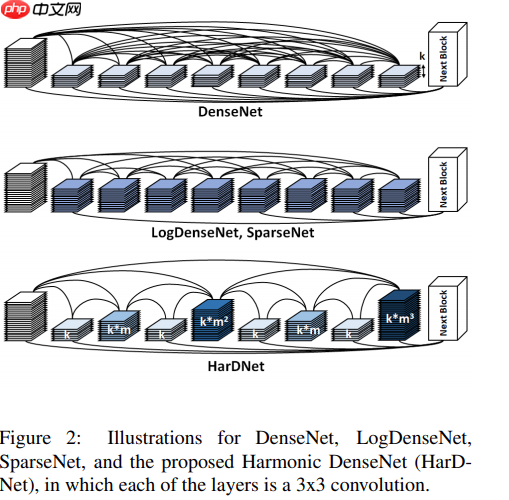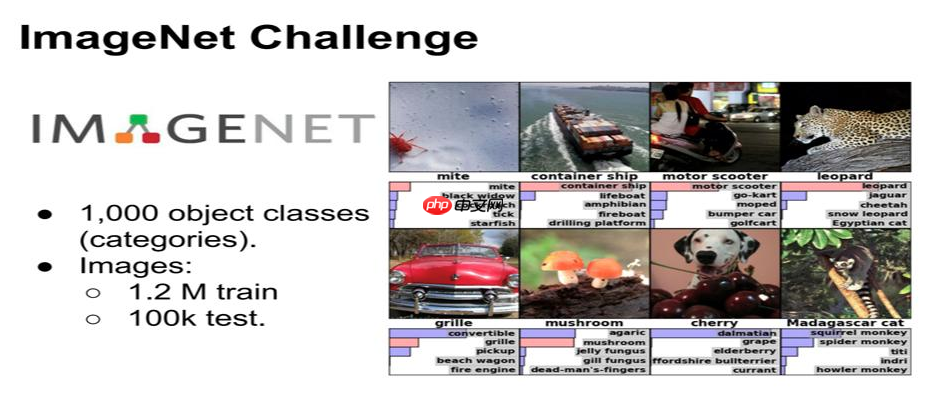本文介绍HarDNet模型,其通过设计CNN减少特征图DRAM内存交互,以CIO为衡量指标,优化计算量与显存交换,提升推理时间30%~40%。文中含Pytorch代码与论文地址,还涉及ImageNet数据集,展示了模型在Paddle框架下的搭建、精度对齐、训练及验证过程,验证精度达0.7605。
☞☞☞AI 智能聊天, 问答助手, AI 智能搜索, 免费无限量使用 DeepSeek R1 模型☜☜☜

HarDNet: A Low Memory Traffic Network
github pytorch代码: https://github.com/PingoLH/Pytorch-HarDNet
论文地址: https://arxiv.org/pdf/1909.00948.pdf


ImageNet图像数据集始于2009年,当时李飞飞教授等在CVPR2009上发表了一篇名为《ImageNet: A Large-Scale Hierarchical Image Database》的论文,之后就是基于ImageNet数据集的7届ImageNet挑战赛(2010年开始),2017年后,ImageNet由Kaggle(Kaggle公司是由联合创始人兼首席执行官Anthony Goldbloom 2010年在墨尔本创立的,主要是为开发商和数据科学家提供举办机器学习竞赛、托管数据库、编写和分享代码的平台)继续维护。
本AIStudio项目在线下进行的训练, 所以只使用了验证集进行验证

#数据集解压!mkdir ~/data/ILSVRC2012 !tar -xf ~/data/data68594/ILSVRC2012_img_val.tar -C ~/data/ILSVRC2012
#加载数据集import osimport shutilimport numpy as npimport paddlefrom paddle.io import Datasetfrom paddle.vision.datasets import DatasetFolder, ImageFolder# from paddle.vision.transforms import Compose, Resize, Transpose, Normalizeimport paddle.vision.transforms as T
train_parameters = { 'train_image_dir': '/home/aistudio/data/ILSVRC2012', 'eval_image_dir': '/home/aistudio/data/ILSVRC2012', 'test_image_dir': '/home/aistudio/data/ILSVRC2012',
}class CatDataset(Dataset):
def __init__(self, mode='train'):
super(CatDataset, self).__init__()
train_image_dir = train_parameters['train_image_dir']
eval_image_dir = train_parameters['eval_image_dir']
test_image_dir = train_parameters['test_image_dir']
data_transforms = T.Compose([
T.Resize(256, interpolation='bicubic'),
T.CenterCrop(224),
T.ToTensor(),
T.Normalize(mean=[0.485, 0.456, 0.406], std=[0.229, 0.224, 0.225])
])
train_data_folder = DatasetFolder(train_image_dir, transform=data_transforms)
eval_data_folder = DatasetFolder(eval_image_dir, transform=data_transforms)
test_data_folder = ImageFolder(test_image_dir, transform=data_transforms)
self.mode = mode if self.mode == 'train':
self.data = train_data_folder elif self.mode == 'eval':
self.data = eval_data_folder elif self.mode == 'test':
self.data = test_data_folder print(mode, len(self.data)) def __getitem__(self, index):
data = self.data[index][0].astype('float32') if self.mode == 'test': return data else:
label = np.array([self.data[index][1]]).astype('int64') return data, label def __len__(self):
return len(self.data)/opt/conda/envs/python35-paddle120-env/lib/python3.7/site-packages/paddle/fluid/layers/utils.py:26: DeprecationWarning: `np.int` is a deprecated alias for the builtin `int`. To silence this warning, use `int` by itself. Doing this will not modify any behavior and is safe. When replacing `np.int`, you may wish to use e.g. `np.int64` or `np.int32` to specify the precision. If you wish to review your current use, check the release note link for additional information. Deprecated in NumPy 1.20; for more details and guidance: https://numpy.org/devdocs/release/1.20.0-notes.html#deprecations def convert_to_list(value, n, name, dtype=np.int):
#构建hardet68网络import paddleimport paddle.nn as nnfrom math import ceilfrom paddle.vision.models import resnet50import pickleimport numpy as npclass ConvBNLayer(nn.Layer):
def __init__(self, in_channels, channels, kernel=3, stride=1, pad=0, num_group=1, bias=False, act="relu6"):
super(ConvBNLayer, self).__init__()
conv_ = None
if stride == 2:
conv_ = nn.Conv2D(in_channels, channels, kernel, stride, [1, 0, 1, 0], groups=num_group, bias_attr=bias) else:
conv_ = nn.Conv2D(in_channels, channels, kernel, stride, kernel//2, groups=num_group, bias_attr=bias)
bn_ = nn.BatchNorm2D(channels)
act_ = None
if act == 'swish':
act_ = nn.Swish() elif act == 'relu':
act_ = nn.ReLU() elif act == 'relu6':
act_ = nn.ReLU6()
self.conv_bn = nn.Sequential(
conv_,
bn_
) if act_ is not None:
self.conv_bn = nn.Sequential(
conv_,
bn_,
act_
) def forward(self, inputs):
return self.conv_bn(inputs)class HarDBlock(nn.Layer):
#获取层连接
def get_link(self, layer, base_ch, growth_rate, grmul):
#检查层
if layer == 0: return base_ch, 0, []
#计算输出的通道数
out_channels = growth_rate
link = [] for i in range(10):
dv = 2 ** i if layer % dv == 0: #间隔2的n次方
k = layer - dv
link.append(k) if i > 0:
out_channels *= grmul
out_channels = int(int(out_channels + 1) / 2) * 2
#计算之前层的输出,也就是当前层的输出
in_channels = 0
for i in link:
ch,_,_ = self.get_link(i, base_ch, growth_rate, grmul)
in_channels += ch return out_channels, in_channels, link def get_out_ch(self):
return self.out_channels def __init__(self, in_channels, growth_rate, grmul, n_layers, keepBase=False, residual_out=False, dwconv=False):
super(HarDBlock, self).__init__()
self.keepBase = keepBase
self.links = []
layers_ = []
self.out_channels = 0 # if upsample else in_channels
for i in range(n_layers):
outch, inch, link = self.get_link(i+1, in_channels, growth_rate, grmul)
self.links.append(link)
use_relu = residual_out
layers_.append(ConvBNLayer(inch, outch)) if (i % 2 == 0) or (i == n_layers - 1):
self.out_channels += outch
self.layers = nn.LayerList(layers_) # print("layers: ", len(self.layers))
def forward(self, x):
layers_ = [x]
for layer in range(len(self.layers)):
link = self.links[layer] # print("HarDBlock layer: ", layer, link)
tin = [] for i in link:
tin.append(layers_[i]) if len(tin) > 1:
x = paddle.concat(x=tin, axis=1) # print("===>concat: ", x.shape)
else:
x = tin[0] # print(self.layers[layer])
out = self.layers[layer](x) # print(x.shape, out.shape)
layers_.append(out)
t = len(layers_)
out_ = [] for i in range(t): if (i == 0 and self.keepBase) or (i == t-1) or (i%2 == 1):
out_.append(layers_[i])
out = paddle.concat(x=out_, axis=1) return outclass HarDNet68(nn.Layer):
def __init__(self, cls_num=1000):
super(HarDNet68, self).__init__() #模型的head
base = []
base.append(ConvBNLayer(3, 32, kernel=3, stride=2, bias=False))
base.append(ConvBNLayer(32, 64, kernel=3))
base.append(nn.MaxPool2D(kernel_size=3, stride=2, padding=1)) #构建HarDBlock
ch_list = [ 128, 256, 320, 640, 1024]
gr = [ 14, 16, 20, 40,160]
n_layers = [ 8, 16, 16, 16, 4]
downSamp = [ 1, 0, 1, 1, 0]
grmul = 1.7
drop_rate = 0.1
blks = len(n_layers)
ch = 64
for i in range(blks): #blk = self.add_sublayer("HarDBlock_" + str(i), HarDBlock(ch, gr[i], grmul, n_layers[i], dwconv=False))
blk = HarDBlock(ch, gr[i], grmul, n_layers[i], dwconv=False)
ch = blk.get_out_ch()
base.append(blk)
# print("fucking...===>", ch, ch_list[i])
base.append(ConvBNLayer(ch, ch_list[i], kernel=1)) # print(self.base[-1])
ch = ch_list[i] if downSamp[i] == 1:
base.append(nn.MaxPool2D(kernel_size=2, stride=2))
ch = ch_list[blks-1]
base.append(nn.AdaptiveAvgPool2D(output_size=1))
base.append(nn.Flatten())
base.append(nn.Dropout(drop_rate))
base.append(nn.Linear(ch, cls_num))
self.base = nn.Sequential(*base) def forward(self, x):
for i, layer in enumerate(self.base):
x = layer(x) return x因为是简单的图像分类模型,这里只做一个相同输入下的输出结果验证

rmTopCMS专属 -- 产品展示模板 -- 简约官网 -- 企业品牌形象设计rmTopCMS简约大气企业模板;专注企业建站用户需求,提供海量各行业模板,降低中小企业网站建设、网络营销成本,致力于打造用户舒适的建站体验。能够以最低的成本、最少的人力投入在最短的时间内架设一个功能齐全、性能优异、易于维护的网站平台。
 0
0

torch的最终输出:

paddle的最终输出:

由于训练集特别大, AIStduio暂时还受不了, 这里只用验证集数据训练了两轮
# 在AIStuido里测试时加载的数据集import cv2from PIL import Image
transforms = T.Compose([
T.Resize(256, interpolation='bicubic'),
T.CenterCrop(224),
T.ToTensor(),
T.Normalize(mean=[0.485, 0.456, 0.406], std=[0.229, 0.224, 0.225])
])# 构建数据集class ILSVRC2012(paddle.io.Dataset):
def __init__(self, root, label_list, transform, backend='pil'):
self.transform = transform
self.root = root
self.label_list = label_list
self.backend = backend
self.load_datas() def load_datas(self):
self.imgs = []
self.labels = [] with open(self.label_list, 'r') as f: for line in f:
img, label = line[:-1].split(' ')
self.imgs.append(os.path.join(self.root, img))
self.labels.append(int(label)) def __getitem__(self, idx):
label = self.labels[idx]
image = self.imgs[idx] if self.backend=='cv2':
image = cv2.imread(image) else:
image = Image.open(image).convert('RGB')
image = self.transform(image) return image.astype('float32'), np.array(label).astype('int64') def __len__(self):
return len(self.imgs)
val_dataset = ILSVRC2012('data/ILSVRC2012', transform=transforms, label_list='data/data68594/val_list.txt')#保存训练结果callback = paddle.callbacks.ModelCheckpoint(save_dir='./checkpoints', save_freq=1)#加载模型及预训练参数model = HarDNet68(cls_num=1000)
run_model = paddle.Model(model)#模型训练optim = paddle.optimizer.SGD(learning_rate=0.0001, weight_decay=6e-5, parameters=run_model.parameters())
run_model.prepare(optimizer= optim,
loss=paddle.nn.CrossEntropyLoss(),
metrics=paddle.metric.Accuracy())
run_model.fit(val_dataset,
val_dataset,
epochs=2,
batch_size=256,
callbacks=callback,
verbose=1)The loss value printed in the log is the current step, and the metric is the average value of previous step. Epoch 1/2
/opt/conda/envs/python35-paddle120-env/lib/python3.7/site-packages/paddle/tensor/creation.py:143: DeprecationWarning: `np.object` is a deprecated alias for the builtin `object`. To silence this warning, use `object` by itself. Doing this will not modify any behavior and is safe. Deprecated in NumPy 1.20; for more details and guidance: https://numpy.org/devdocs/release/1.20.0-notes.html#deprecations if data.dtype == np.object: /opt/conda/envs/python35-paddle120-env/lib/python3.7/site-packages/paddle/fluid/dataloader/dataloader_iter.py:89: DeprecationWarning: `np.bool` is a deprecated alias for the builtin `bool`. To silence this warning, use `bool` by itself. Doing this will not modify any behavior and is safe. If you specifically wanted the numpy scalar type, use `np.bool_` here. Deprecated in NumPy 1.20; for more details and guidance: https://numpy.org/devdocs/release/1.20.0-notes.html#deprecations if isinstance(slot[0], (np.ndarray, np.bool, numbers.Number)): /opt/conda/envs/python35-paddle120-env/lib/python3.7/site-packages/paddle/fluid/layers/utils.py:77: DeprecationWarning: Using or importing the ABCs from 'collections' instead of from 'collections.abc' is deprecated, and in 3.8 it will stop working return (isinstance(seq, collections.Sequence) and /opt/conda/envs/python35-paddle120-env/lib/python3.7/site-packages/paddle/nn/layer/norm.py:648: UserWarning: When training, we now always track global mean and variance. "When training, we now always track global mean and variance.")
step 196/196 [==============================] - loss: 6.9567 - acc: 0.0010 - 3s/step save checkpoint at /home/aistudio/checkpoints/0 Eval begin... The loss value printed in the log is the current batch, and the metric is the average value of previous step. step 196/196 [==============================] - loss: 7.0047 - acc: 8.6000e-04 - 2s/step Eval samples: 50000 Epoch 2/2 step 196/196 [==============================] - loss: 7.0444 - acc: 0.0011 - 3s/step save checkpoint at /home/aistudio/checkpoints/1 Eval begin... The loss value printed in the log is the current batch, and the metric is the average value of previous step. step 196/196 [==============================] - loss: 7.0022 - acc: 0.0010 - 2s/step Eval samples: 50000 save checkpoint at /home/aistudio/checkpoints/final
验证的最终效果能接近论文的精度
model = HarDNet68(cls_num=1000)
model_state_dict = paddle.load("/home/aistudio/work/hardnet_best.pdparams")
model.set_state_dict(model_state_dict)
run_model = paddle.Model(model)#模型训练optim = paddle.optimizer.SGD(learning_rate=0.0001, weight_decay=6e-5, parameters=run_model.parameters())
run_model.prepare(optimizer= optim,
loss=paddle.nn.CrossEntropyLoss(),
metrics=paddle.metric.Accuracy())
run_model.evaluate(val_dataset, batch_size=256, verbose=1)Eval begin... The loss value printed in the log is the current batch, and the metric is the average value of previous step. step 196/196 [==============================] - loss: 0.9377 - acc: 0.7605 - 2s/step Eval samples: 50000
{'loss': [0.9376896], 'acc': 0.7605}以上就是HarDNet:一个低内存占用率网络的详细内容,更多请关注php中文网其它相关文章!

每个人都需要一台速度更快、更稳定的 PC。随着时间的推移,垃圾文件、旧注册表数据和不必要的后台进程会占用资源并降低性能。幸运的是,许多工具可以让 Windows 保持平稳运行。

Copyright 2014-2025 https://www.php.cn/ All Rights Reserved | php.cn | 湘ICP备2023035733号